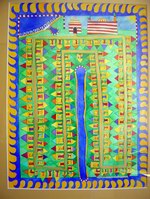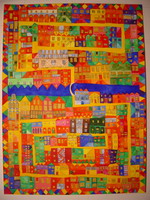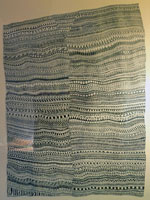 |
 |
 |
||||||
| grid 2d3d | stacked | line | anabatic | single road | no entrancexit | carpet |
"art is the sedimented history of human misery." Theodor Adorno
The invitation has performed its everyday magic. It has collected us here through the spell of its hieroglyphs and the invisible relationships of proximity and curiosity.
Holding your drinks, your cigarettes, your handbags, you are surrounded by open carcasses on the walls that surround you:
These dissections reveal traces of movement, of memory, of mood of judgement. Our words spoken in jest or anger, the ash from our cigarettes, the spills of beer, the condensation of our breath and the mud of our shoes, the rubbing of our perspiration staining our clothes, dirtying the floor, moving the furniture, leave traces of ourselves wherever we go: on the walls, on paper, on our sheets. These traces are the evidence of our holy communion with daily life. Such traces are the foundation of all forms of expression and so of a rather grand and mysterious project carried, not with the weight of of warning but with the lightness of inevitability.
Georges Bataille let his finely warped mind roam through the spaces of our time. Among others, the slaughter house. While he was there among the red meat and the curiously emasculated forms of skinned and meticulously dismembered animals, a fundamental fact about modern life struck him.
Slaughter used to be, and in some countries still is, a religious activity. How then did the slaughterhouse come to be divided from the temple? The life of the animal was a gift to man, the animalís death in sacrifice was -in turn- our gift to the divine. The blood was the evidence of our involvement. What have we done in our rush to modernity? In cleaning up the temple, in removing the blood and the flesh, replacing them only with metaphors and symbols, have we not lost ourselves in our hygiene? Has our cleanliness not separated us from our involvement with the world?
Almost in the same breath, Bataille writes about museums. And there, by some silent rhetorical conspiracy, he answers his own question. Museums and Galleries are the product of the separation between the temple and the slaughterhouse. Art is the simulation of slaughter. At the same time it is the genuine product of sacrifice. Art is the evidence of our involvement: it traces our thought, our worries and sensibilities. They rub off on the canvass and confront us with our awesome project: daily life.
Art makes us conscious of the fact that the separation between ourselves and the blood and gore of sacrifice is actually incidental. The slaughter goes on in daily life, in our effort to maintain and become. The deepest art represents the mystery of the everyday.
Theodor Adorno asked if art merely shows us what we are, in our narrowness or whether it does not provide the conceptual space into which we can expand and grow. Or, as Nietzsche said it behind the generous hairs of his moustache, to become what we are.
If that is true then art is the graph of our personal struggle into humanity, the graph of our exertions to become larger and more generous in our conception. That is our grand project.
Galleries are slaughterhouses disguised as temples. They have the function of surrounding us with the awesome revelatory carcasses of the mind, which show us ourselves, so that we may see ourselves from the inside, so that we may see the immense amount of space still available for us to occupy, grow into and fill.
The cities i make are drawn and coloured in as children imagine their universe. They are intended for children, who like them well enough to grow into. As to their composition they are the result of a simple game. They take off from a decision about the way the road organises and shapes the texture of the city. The road is not a thing, it is the potential of a progress, it is an emptiness that behaves as the podium in a theatre. Roads can thus become metaphors and banal symbols of our way of describing things, but they are also more. As such the way they are organised determines the potential order of the city as a universe in which to dwell as a small god.
The elements within the paintings have a shade of meaning put into them by me. But the meanings imposed by me are banal and never stable, what is anything but banal is the possbility to read creatively into the picture.
Some of the devices I employ I am proud of however, and will confine for you. For example the fact that my God loves Greek architecture enough to train his waves into a fret. Perhaps just to annoy Ruskin. My cities are populated by myth, for myth even in the world of the infant-grown-up is the prime cause of form and organisation of a city. And so my cities have creatures, hollow creatures of huge dimensions, that quietly and facelessly swim around, fight over and support the very structure of the city.
Contact me at: jacob@voorthuis.net
copyright © jacob voorthuis 1994-2012. All written material on this site is copyrighted. Please cite Jacob Voorthuis as the author and Voorthuis.net as the publisher.